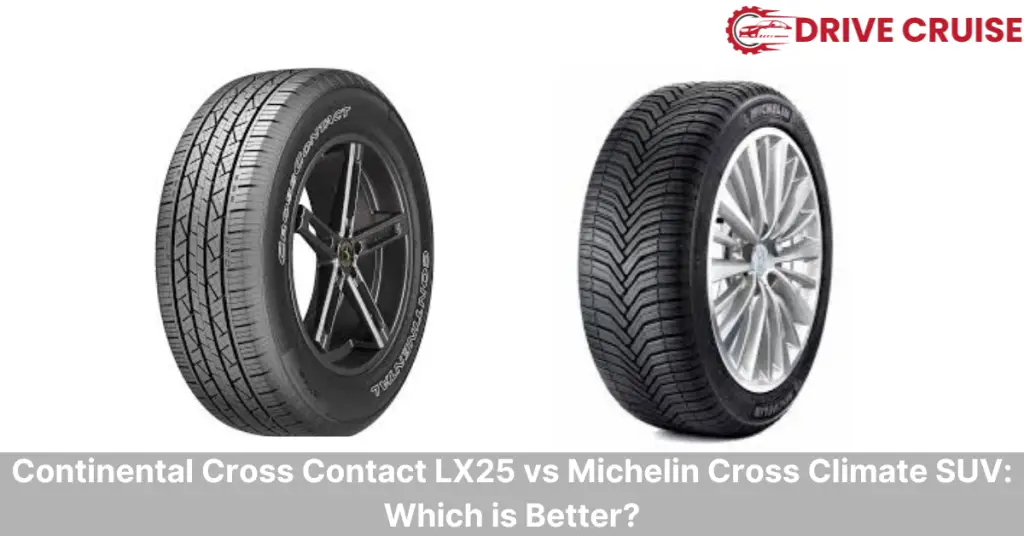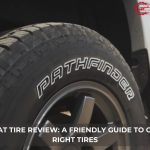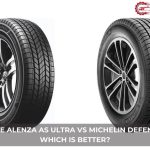When it comes to all-season tires for your SUV or crossover, the Continental CrossContact LX25 and Michelin CrossClimate SUV are two of the most popular options on the market. Both are designed to provide excellent performance in a variety of weather conditions, making them versatile choices for drivers who want to be prepared for anything.
When choosing between these two tires, there are several factors to consider. First and foremost is performance – you want a tire that can handle wet, dry, and snowy conditions with ease. Additionally, you’ll want to consider durability and load capacity, as these factors can impact the overall lifespan and safety of your vehicle. By weighing these factors carefully, you can make an informed decision about which tire is right for your needs.
Performance Breakdown: A Deep Dive
Tread Design and Technology
When it comes to tread design and technology, the Continental CrossContact LX25 and Michelin CrossClimate SUV have their unique features. The Continental CrossContact LX25 has a focus on wet weather performance, thanks to its siping design that helps with water evacuation. On the other hand, the Michelin CrossClimate SUV is designed for all-season capability, with winter tread elements that provide additional grip on snowy roads.
Dry Performance Handling
In terms of dry performance handling, both tires offer excellent grip, responsiveness, and steering feel during cornering maneuvers. The Continental CrossContact LX25 has a stable and predictable feel, making it well-suited for SUVs and crossovers. The Michelin CrossClimate SUV also offers excellent handling, but it has a slight advantage when it comes to stability and handling on SUVs and crossovers.
Wet Weather Performance
When it comes to wet weather performance, the Continental CrossContact LX25 has a siping design that helps with water evacuation, making it resistant to hydroplaning. The Michelin CrossClimate SUV, on the other hand, has tread elements designed for water evacuation, which helps with channeling and grooving. In terms of stopping distances on wet surfaces, both tires perform well, with the Michelin CrossClimate SUV having a slight advantage.
Light Snow Traction
For light snow traction, both tires offer all-season capabilities with biting edges and sipes in the tread patterns for snow grip. However, it’s important to note that these tires have limitations compared to dedicated winter tires. If you live in an area that experiences frequent snow and ice, it’s recommended to switch to dedicated winter tires for maximum safety.
Comfort and Noise Levels
When it comes to comfort and noise levels, the Continental CrossContact LX25 has a supple ride quality, making it comfortable for SUVs and crossovers. The Michelin CrossClimate SUV also offers a comfortable ride, but it generates more noise due to its tread pattern.
Treadwear and Expected Lifespan
In terms of treadwear and expected lifespan, both tires have a UTQG treadwear rating, with the Continental CrossContact LX25 having a rating of 700 and the Michelin CrossClimate SUV having a rating of 600. However, it’s important to note that the actual lifespan of the tire can vary depending on factors such as driving style and road conditions. Based on manufacturer’s information and real-world user reviews, both tires have a long lifespan and offer excellent value for money.
Additional Considerations for SUVs and Crossovers
Load Capacity and Durability
When choosing tires for your SUV or crossover, it’s important to consider the load capacity and durability of the tires. The weight of these vehicles can put a lot of stress on the tires, especially when towing or carrying heavy loads. Both the Continental CrossContact LX25 and Michelin CrossClimate SUV are designed to handle the weight and demands of these types of vehicles.
The load index rating of a tire indicates the maximum weight it can support when properly inflated. The CrossContact LX25 has load index ratings ranging from 100 to 116, while the CrossClimate SUV has load index ratings ranging from 102 to 110. This means that the CrossContact LX25 can support more weight than the CrossClimate SUV in some sizes.
Durability is also an important consideration for SUVs and crossovers. The sidewalls of these tires need to be strong enough to handle the weight and demands of these vehicles. Both the CrossContact LX25 and CrossClimate SUV are designed with durable sidewalls to provide added protection against damage from curbs, potholes, and other hazards on the road.
Fuel Efficiency
Fuel efficiency is an important consideration for any vehicle, including SUVs and crossovers. The rolling resistance of a tire can impact fuel efficiency, with lower rolling resistance resulting in better fuel economy. While there are no specific rolling resistance ratings available for the CrossContact LX25 and CrossClimate SUV, user reviews suggest that both tires provide good fuel economy for their class.
Price Point Compared to Competitors
When shopping for tires for your SUV or crossover, it’s important to consider the price point. The CrossContact LX25 is priced at an average of $205, while the CrossClimate SUV is priced at an average of $240. While the CrossClimate SUV is more expensive, it offers superior wet performance compared to the CrossContact LX25.
Warranty Coverage
Manufacturer warranty terms can also be an important consideration when choosing tires for your SUV or crossover. The Continental CrossContact LX25 comes with a limited treadwear warranty of up to 70,000 miles, while the Michelin CrossClimate SUV comes with a limited treadwear warranty of up to 60,000 miles. Both tires also come with road hazard warranties to protect against damage from road hazards like nails and potholes.
Choosing the Right All-Season Tire for Your SUV/Crossover
When it comes to choosing the right all-season tire for your SUV or crossover, there are several factors to consider. Two popular options in the market are the Continental CrossContact LX25 and the Michelin CrossClimate SUV. Here is a breakdown of the ideal applications for each tire to help you make an informed decision.
Ideal Applications for Each Tire
Continental CrossContact LX25 vs Michelin CrossClimate SUV
If you prioritize primarily dry and wet weather performance for everyday driving, the Continental CrossContact LX25 is an excellent option. It offers a smooth and quiet ride, and Continental designed the tire for longevity, with the capability to last up to 65,000 miles before replacement is needed. Additionally, the LX25 is potentially a more affordable option compared to the Michelin CrossClimate SUV.
On the other hand, if you prioritize all-season capability with better performance in light snow conditions, the Michelin CrossClimate SUV is the way to go. It is superior in wet performance and provides a focus on comfort and potentially lower noise levels. However, it is 17% more expensive than the CrossContact LX25.
Conclusion: Selecting the Optimal All-Season Option
In summary, the Continental Cross Contact LX25 and the Michelin Cross Climate SUV are both solid choices for all-season tires. Here are some of their key strengths and weaknesses:
Continental Cross Contact LX25
Strengths:
- Excellent dry handling
- Low road noise
- Long tread life
- Good fuel efficiency
Weaknesses:
- Average wet performance
- Limited snow capability
The Continental Cross Contact LX25 is a great option for drivers who prioritize dry handling and a quiet ride. It’s also a good choice for those who want a tire that will last for a long time.
Michelin Cross Climate SUV
Strengths:
- Superior wet performance
- Good snow capability
- Comfortable ride
- Fuel-efficient
Weaknesses:
- More expensive than the Continental Cross Contact LX25
- Slightly noisier than the Continental Cross Contact LX25
- Shorter tread life than the Continental Cross Contact LX25
The Michelin Cross Climate SUV is an excellent choice for drivers who frequently encounter wet or snowy conditions. It also provides a comfortable ride and good fuel efficiency.
When selecting the optimal all-season option for your SUV or crossover, it’s important to consider your individual driving needs, climate conditions, and vehicle usage. For example, if you frequently drive on the highway or only encounter light snow, the Continental Cross Contact LX25 may be the better choice. On the other hand, if you live in an area with frequent rain or heavy snow, the Michelin Cross Climate SUV may be the way to go.
Ultimately, we recommend consulting a tire professional for specific recommendations based on your SUV/crossover and driving habits. They can help you choose the best tire for your needs and ensure that you stay safe on the road.
Related Posts:
- Comparing Michelin CrossClimate 2 vs Nokian WR G4: A Friendly Tire Showdown
- Continental Cross Contact LX25 vs Michelin Cross Climate SUV: Which is Better?“
- Falken Wildpeak AT3W vs BFG KO2: Which is the Better Off-Road Tire?
- Goodyear Assurance MaxLife Review: A Friendly Guide to Choosing the Best Tires
- Goodyear Assurance MaxLife vs Michelin Defender2: Which One is Right for You?
- Goodyear vs Michelin: Which Tire Brand is Better?
- Michelin Defender2 Review: A Friendly Guide to Choosing the Best Tires
- Yokohama vs Bridgestone: Which Tire Brand is Better?







